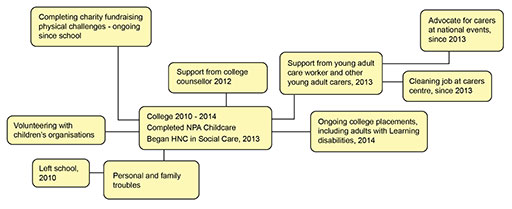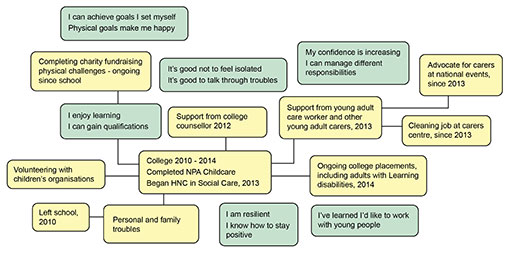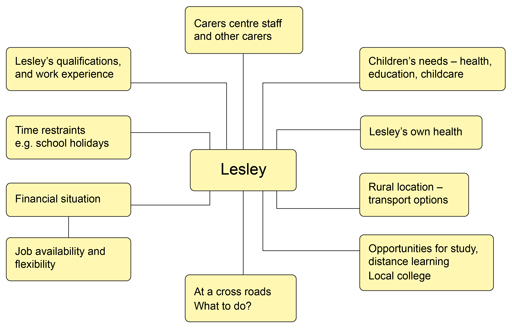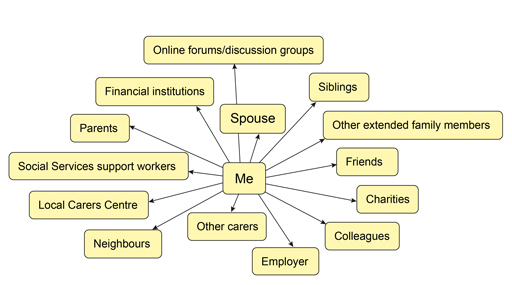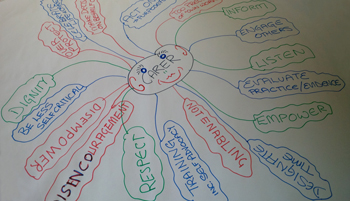Use 'Print preview' to check the number of pages and printer settings.
Print functionality varies between browsers.
Printable page generated Thursday, 27 November 2025, 1:26 PM
Guide for facilitators
Guide for facilitators
This short guide provides information and advice for facilitators on how to make the best use of the course when working with individuals or groups.
What is Caring Counts: a reflection and planning course for carers?
This is a flexible online course built around the stories and experiences of a range of carers who share their lives in text and on film. Activities take the learner through a process of self-reflection in order to help them value the knowledge and skills they’ve acquired in their caring role, and to plan and make decisions about their future.
You can use the course with individual carers, in facilitated groups, or as a blended learning approach, combining self-directed learning with group support. The course can be completed over a couple of intensive sessions, or over a few weeks. This guide gives some ideas on how it might be used.
The course is designed to be used online. Alternatively, it can be downloaded on a memory stick and used offline on a computer or e-reader, or printed out and completed with just pen and paper. It is a free and flexible learning resource.
Learners record their activities and reflections in their Reflection Log, either on their computer or on paper. As they work through the course, learners are invited to answer quiz questions after some sections. These are mostly multiple choice or matching questions designed to be enjoyable and are completely optional. Learners who successfully complete the final compulsory quiz will receive a digital badge to recognise their achievement.
Who is the course for?
The course is for carers of any age or at any stage in their life or caring role who are interested in thinking about their situation, reflecting on their experiences and thinking about the present and their future. The process of reflection will help carers to identify and value the skills and qualities they have developed through their caring role.
The course can also be used by support workers and other non-carers to gain a clearer understanding of carers’ experiences, and to recognise the range of skills and qualities that people develop in a caring role.
The course includes information about career planning for young adult carers, or adult carers thinking about returning to work or to education they may have had to put on hold while caring. The course may be particularly valuable for those whose caring role has come to an end and who are thinking about their next steps.
Some carers may be interested in learning about something related to their caring role, to support them in providing the best care they can, or they may want to try something completely different. The Open Pathways to Higher Education resource can help learners to plan their next steps.
How long does it take?
The course is designed to be flexible. Learners can work at their own pace and there is no fixed time limit. We have estimated 10 hours spread over several weeks, but some learners may spend less time while others may take much more. It depends on how you choose to work through the course – some learners may take a while to develop their IT skills if they are not used to learning online.
The suggested times for how long activities may take are just guidelines. Keep in mind that group discussions will take more time than individual reflections. We suggest that the course is spread over a few weeks so that learners can mull over ideas and thoughts as they progress.
How can carers centres use this course?
We suggest that the facilitator completes the course first, to get an idea of how it might work best for the carers you work with. The course is flexible and adaptable, so can be used by carers working online individually, as a course run over a number of group sessions, or as a blended approach with self-directed learning, online discussion and group activity sessions.
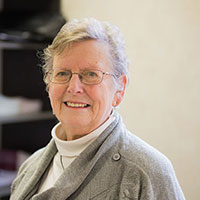
Open University associate lecturer Meg Hopkins supported a group of carers in Dumfries through their reflection journey. They met as a group, as well as working individually through the activities.
The ideas below have come from a range of organisations that have made use of courses like this to support learners to reflect and make plans.
- Use it on a one-to-one basis to support a carer, arranging a series of individual sessions to discuss the activities the carer has completed at home.
- Incorporate it into other courses you run, such as encouraging learners to learn information technology skills or financial planning. The course works well as a practical way to test and motivate learners to use newly acquired IT skills.
- Deliver it online (if they have internet access) to a group for those in remote or rural areas or for carers who simply can’t get along to meetings. There are many options to support online discussion and interactive activity, such as a forum, a wiki (editable web page), social media, conference calls or online conferencing.
- Encourage individuals to come along to a taster session as a first step towards thinking about getting back into study or finding out about other options. Sometimes people know they want to do something, but they’re not sure what. This course is a gentle and flexible first step into working out what that something is.
- Encourage those who come along to your support groups to have a go. You don’t have to deliver it at set times, but you can discuss key parts of the course while individuals work at their own pace at home or within the group.
- Introduce the course alongside a range of other learning choices, such as free OpenLearn courses or Open University access courses. You could use the Open Pathways to Higher Education as a guide.
- Perhaps you have limited time and carers who have a clear idea of what they want to do already – if so, pick out the parts of the course that will meet their needs. Look at the career and action planning sections to help them work out their next steps.
Caring Counts is an open educational resource made available with a Creative Commons licence. This means you are free to adapt it to suit the needs of your learners.
What do carers get if they finish the course?
Reflection Log
As learners work through the course, they record their thoughts and plans for their future in their Reflection Log. This doesn’t have to be completed on a computer – it can be done with pen and paper. What’s useful is to keep all the notes, thinking and reflection in one place, as this becomes a reference for whatever they choose to do next.
This record might help in conversations with careers advisors or college staff, or in discussions with social or health services, for example when they discuss a carer’s support plan. Learners should finish the course with an action plan to match their chosen goal, whatever that might be.
Caring Counts badge

Figure 2 Digital badge
At the end of some sessions there is an optional quiz. If learners choose to enrol on the course and successfully complete the quizzes, they can gain a digital badge in recognition of their achievement.
The Caring Counts badge shows that learners have gained an understanding of the process of reflection and personal planning, and have achieved the learning outcomes listed within the course.
Carers have told us that they found the badge useful when applying for jobs, as it created a talking point, gave them an opportunity to articulate the skills they’d gained from caring, and helped to account for gaps in their work history when they had to give up work to care.
You can find out more about how to complete the quizzes and how to gain a badge in the introduction section of the course and on these pages:
How do I start?
Learners working individually can just go online and get started. Learners who wish to gain a badge can enrol and create an Open University account.
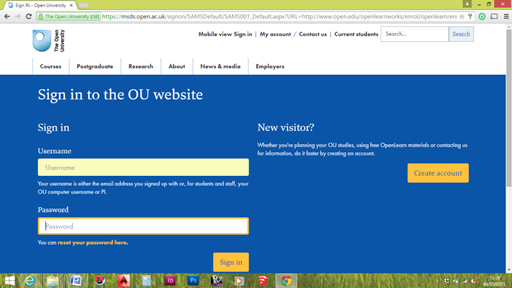
Learners will need access to a computer and a printer to save and print their individual activities or their completed Reflection Log at the end of the course. Make sure there is somewhere secure to save documents on a computer if learners are going to record their work in this way. For learners who do not have internet access at home, the course materials can be downloaded onto a memory stick so they can work offline.
Learners can start and stop the course as they like. It’s completely flexible and there’s no time limit. Repeat a section, print sections, photocopy them or project the course from a computer for shared viewing – it’s up to you and the carer who is completing the course.
If your learners are not confident using IT and the internet, it might be useful to run a digital skills session with them before starting the course so they are confident about learning online.
Making time for learning
Carers are busy people, and the demands of their caring role might make it difficult for them to find the time for learning at home. They might also feel guilty about taking time for themselves. However, carers who have completed Caring Counts have told us that they gained so much from the course it was worth making the time for it. Here are some tips from them on how they managed to find the time for learning.
- Getting up early to study when the house was quiet.
- Studying when the person they cared for was out walking the dog.
- Delegating housework to other family members – who were more appreciative of all the carer does when the course was finished!
Facilitating activities
The course is designed to be learner-centred and flexible so people can learn in the way that suits them best. Before offering the course, discuss with the carers who are interested how they would like to work through it. Some learners may prefer to work alone, some in a group, and some may opt for a combination. A ‘Getting Started’ session can explore learners’ preferences for delivery, help them to navigate the course, and ensure that they can enrol (if they choose to).
Each session contains a number of activities, all of which are outlined in the Reflection Log. If you are delivering this course in a blended format, where the learners undertake some of the course online and some in face-to-face sessions, many of the activities are suitable to carry out with a group of learners. Group sessions can help learners to share ideas and keep motivated as they work through the course. Facilitators have told us that the timeline activities in Session 2 and the ‘Thinking about something for me’ in Session 4 work particularly well as group activities.
Some are reflection activities, which learners can do on their own, though they may be interested in discussing them afterwards, either in a group session or an online forum. You should set some ground rules before these discussions take place, to help learners feel more comfortable sharing their thoughts. You might want to discuss with the group what might be included in these ground rules. For example:
- Learners should only discuss what they feel comfortable with. If they have reflected on aspects of their personal lives, they do not have to share these with the group.
- Anything shared with the group stays within the room. Learners should trust that what they say will not be shared with others.
In the following sections we have provided some tips for facilitating the activities in each session of Caring Counts.
Session 1
Activity 1.1
Activity 1.1 Roles and responsibilities
The examples of Jade, Janet and Dean show how we have different roles in life. In fact we all have many roles in which we use a variety of skills and abilities. Encourage the group to think about their own skills and abilities. This can be done as a group activity or as a prompt for online discussion.
You could use magazines or the internet for text and images that illustrate carers’ roles and responsibilities and compile them into a collage or montage. You could also do this activity online as a wiki, which can be added to and edited by all the members of the group to form a picture of their various roles and responsibilities.
| My main roles in life | What I do |
|---|---|
| Write your comments here. | Write your comments here. |
Ask the learners the following questions, which can be discussed in a group:
- Do you have roles and responsibilities that are similar to those of Jade, Janet or Dean?
- Carers often describe juggling and balancing a number of different roles. Is that an experience you’re familiar with?
- Have you got goals you’d like to achieve?
Activity 1.2
Activity 1.2 Thinking about myself
This activity can be done first as a personal reflection, using the table provided in the Reflection Log. Learners could then bring it back to the group for discussion. Alternatively, learners’ thoughts could be represented visually and this could be done after the reflection, as part of a group.
One idea is to create a mood or a vision board. This can be a fun and creative way for learners to get insight into their thinking. Before the session, you will need to gather (or ask learners to bring) a range of catalogues, magazines and newspapers, some scissors, glue, coloured paper, maybe even some glitter!
Encourage them to flick through the magazines until they see images or words that catch their attention. They can cut or tear out that page, gathering pictures and words that summarise their thoughts. Sometimes a creative activity can release thoughts or ideas that people find difficult to put into words.
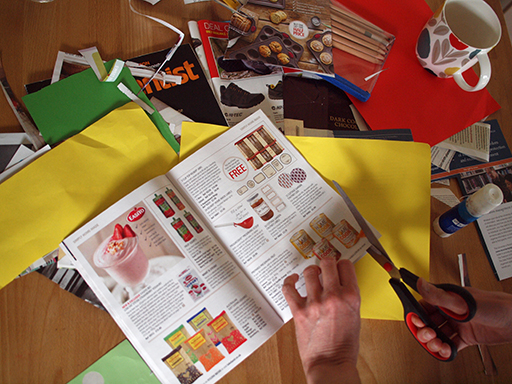
Arrange the images into a collage, creating a record of the learners’ feelings or their ambitions – whatever they choose to show. You can create a group display, or learners may prefer to take their collage home and put it somewhere prominent to give them a visual reminder of their ideas.
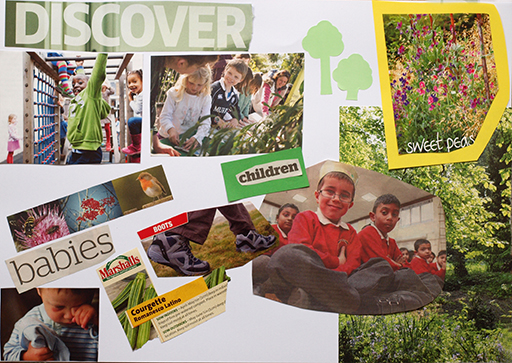
Session 2
Activity 2.1
Activity 2.1 Taking stock of my experiences over time
If you are combining this activity with the My Timeline activity (2.2) as a group session, ask learners to prepare for the session by reflecting on Lesley’s and Scott’s experiences beforehand. They should make some notes (either in their notebook or in their Reflection Log) on the questions below and bring them along to the activity session.
Everyone’s ups and downs are different. Ask the learners to consider the following:
- Do you have anything in common with Lesley’s experiences?
- Do you have anything in common with Scott’s experiences?
- What is different about your experiences?
- What period of your life would you like to reflect on and put into a timeline?
Activity 2.2

Activity 2.2 My timeline
Before the session: If you are working offline, gather what you may need for a creative session, such as paper, pens of different colours, templates, arts and crafts. If working online make sure there is access to a printer.
Having looked at the timeline examples in Session 2, learners can create their own timelines. What they decide to include in the timeframe is up to them – it can include their whole life since childhood, or focus on recent study or work experiences, or just their life as a carer. They should reflect on this before the group activity. They do not need to include anything that they want to keep private.
The timeline can be done in a number of ways. You can work as a group or allow learners to choose the method they prefer. Remember, not everyone will choose to be creative and there should be no expectations of what the timelines will look like. Here are just some ideas:
- Using a pen and paper, position positive experiences higher than negative ones to create a simple timeline (there is a template in the Reflection Log).
- On a computer, using Microsoft Word or a similar programme, the timeline can be represented as a diagram.
- Another option is to use bubbl.us, which is free online software, to create images similar to the ones used in the course. Go to bubbl.us and click on Learn more – this will show you how to get started. This online tool can be used for free but requires you to sign up for a free account. (This is not an Open University website and the OU is not responsible for third party websites such as this or the information you choose to share with them.) If you prefer not to use bubbl.us, or any other online tools, don’t worry – pen and paper will do just as well!
- Encourage learners to think of creative ways to visualise the timelines, getting as artistic as they choose. Some learners have produced timelines using Celtic strapwork, with the low points going under the high points to create a pattern. Others, who are adept at crafts, have even created woven timelines.
- If learners prefer, they can just make a list of the high points and low points of the period of their life and reflect on these.
- Learners can also draw sketches or cartoons, with or without words.
Carers may have other ways of representing their timeline. What is important in this activity is their understanding from their experience. Try to put low points lower down the page and high points above them, just as Lesley and Scott have done, but some learners may have fewer ups and downs and can just list them side by side.
If learners are working online, remind them to save and/or print out their timelines, as they will be referring to them in Activities 2.4 and 2.5. These activities can be done as part of the same group session or learners can choose to take their timelines home and complete the activities individually.
Activity 2.3
Activity 2.3 Learning from experience
This can be either a reflection or a discussion activity. Having listened to Lesley talk about what she has learned from her caring experience, learners can discuss the following:
- Was some of Lesley’s learning unexpected?
- Did she learn from difficult times as well as good ones?
- Did Lesley learn things while caring that may be useful in studying and employment?
You can prompt the discussion, picking up on some key words from Lesley’s story, such as: resilient, managing her time, budgeting, managing stress, capable of learning, coping with difficult situations, communication skills.
Activity 2.4
Activity 2.4 Learning from my experience
Learners can look at the timelines they created in Activity 2.2 and think about the skills and qualities they have gained from their experiences. They can add their learning points to the timeline, perhaps using a different colour.
Learners may prefer to do this activity alone, but you can invite them to share and discuss their learning points with the group if they feel comfortable doing this. Remind them to save their timeline if doing this activity online.
Here are some questions to consider:
- Looking over the ups and downs, does it help you to recall how you felt at each point?
- What did you learn from each situation?
- Perhaps you found out more about yourself and your ability to just keep going: qualities such as resilience, adaptability or reliability?
If working as a group, learners may choose to share and discuss their learning points with others.
Activity 2.5
Activity 2.5 Influences and choices
This activity can be done as part of the same timeline group session, or learners may choose to do this individually in their Reflection Log. Using the same software or other methods suggested for Activity 2.2, they can create a spider diagram of their influences and choices.
Session 3
Activity 3.1
Activity 3.1 Thinking about my skills and qualities
This is a reflection activity that learners can work on individually in their Reflection Log, but you could also use it to prompt discussion in a group session or an online forum. This activity invites learners to think about how their experiences highlight the skills and qualities they have developed. They can pick an event or a point in their timeline when they had to take action to resolve something. It could be something to do with caring, family, work, or practical issues like housing and money.
Using the following questions, they can make some notes in their Reflection Log or notebook:
- Did you find that you used some of the same skills that the carers described?
- Did you discover that you have other skills, maybe some that you were not aware of?
- Are you now aware of qualities that you have but hadn’t considered before?
These may or may not be the same as those suggested by the carers in this session. This table provides some examples.
| Skills | Qualities |
|---|---|
| Time management | Patience |
| Prioritisation | Resilience |
| Multi-tasking | Emotional intelligence |
| Organisational skills | |
| Communication | |
| Critical thinking |
Session 4
Activity 4.1
Activity 4.1 Thinking about something for me
This works well as a group activity, and some facilitators have said that this is a pivotal point in the course where carers’ motivation might flag without support. This is also a good opportunity to introduce Open Pathways to Higher Education.
If you have computer and internet access for the group, you could combine this with Activity 5.1 Using the computer to explore ideas.
Learners don’t have to identify a specific course, but can begin to think about what other things they might be interested in doing. They can use the table below to record their ideas, or use magazines or the internet to find text and images to compile into a collage or montage.
| What I’d like to learn more about | Why I’d like to learn about this |
|---|---|
| Write your comments here. | Write your comments here. |
Session 5
Activity 5.1

Activity 5.1 Using the computer to explore ideas
If the learner you are supporting is focused on returning to work, you may want to give this activity a significant amount of time to fully explore their ideas and options. If that is not their main aim, carers may choose to do this individually or not at all. Using IT can help build learners’ skills and confidence as they research and explore ideas.
The job profiles in the list below come from the National Careers Service job profiles web page. Ask carers to select two job profiles that they may be interested in, and explore the information given for each. Ask them to look for information on:
- The entry requirements for their chosen job profile.
- Two skills that are required for their chosen job profile.
Make a note of any points that particularly interest or surprise the group. Discuss the answers that they come up with. Looking back at previous activities in their Reflection Log (such as 3.1), compare some of the skills and qualities required for the jobs with the skills and qualities that carers have identified in themselves. Ask learners to keep notes from this activity to help them set goals in the next session.
Session 6
Activity 6.1
Activity 6.1 Clarifying my goals through visualisation
This can be done by carers individually in their Reflection Log or you can facilitate a creative visualisation session with the group.
Give learners some time to visualise themselves in the future. Where are they? What are they doing? Allow them scope to consider that there are possibilities open to them. What are their hopes and plans for the future?
A good way to do this is to create a picture of what that future might look like: either by drawing a picture, a diagram or a word cloud, or by creating a montage of images and words. Provide plenty of newspapers and magazines for carers to use to find images and text. If they are more comfortable with words, they can also write a story. Remind them to keep their work for later use.
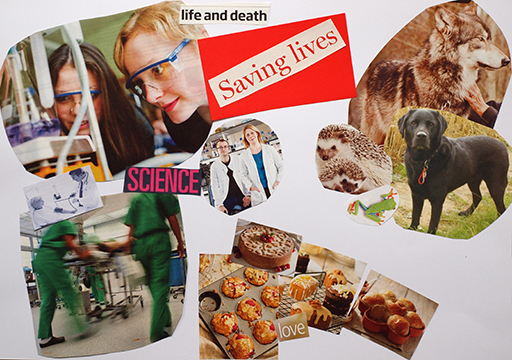
Activity 6.2
Activity 6.2 Thinking about my goals: factors that might help or hinder me
Referring to their notes for Activity 6.1 and using the table in the Reflection Log as a template, ask learners to list in the first column of the table the factors that will help them. In the second column they should list the factors that might give them difficulties as they try to achieve their goals.
In the first column they could include, for example, that they:
- are well organised
- have time available
- communicate well
- have enthusiasm.
In the second column, as well as their caring responsibilities, they might include:
- financial issues
- time constraints
- transport difficulties
- qualification gaps or no qualifications.
| Positive factors | Possible difficulties |
|---|---|
| More time available | Lack of time |
| Good health | Poor mental health, poor physical health |
| Communication skills | Unpredictability of caring role |
| Flexible | No childcare |
| Resilience | Lack of confidence |
| Adaptability | Lack of transport |
| Knowing what I want to do | I don’t know what I want to do |
| Maturity | No space to study |
| Ability to manage and juggle different activities | Financial worries |
| Supportive employer | Inflexible employer |
| Open to try new things | Don’t know where to go for help |
| Good support network | Lack of support networks – family live far away |
Activity 6.3
Activity 6.3 My support network
This would work well as a group activity.
Having explored the different factors that might help or hinder carers achieve their goals, and listened to the carers on the course discuss the support they have accessed, break into small groups of 3–5. Provide each group with flip-chart paper and pens in different colours, or they can use an online tool like www.bubbl.us.
Go to bubbl.us and click on Learn more – this will show you how to get started. This online tool can be used for free but requires you to sign up for a free account. (This is not an Open University website and the OU is not responsible for third party websites such as this or the information you choose to share with them.) If you prefer not to use bubbl.us, or any other online tools, don’t worry – pen and paper will do just as well!
Each group should draw a spider diagram with ‘carer’ in the centre. Using one colour, illustrate the support the carers already have in their lives with a ‘leg’ for each source of support. This might be from family and friends, from social services, at work or from the carers centre. Using a different colour, add other sources of support that might also be available. Finally, discuss support that isn’t currently available but might help the learners to achieve their goals. Add these ideas in a different colour.
As a group, discuss the ideas for further support. Using the list of websites given in the Resources section of this course, try to identify sources of support that learners could access to help achieve their goals.
Session 7
Activity 7.1
Activity 7.1 My long-term goal and first next step
Carers can complete this activity individually, but if you are working in a group they may want to share and discuss their plan. If you are working with a carer on a one-to-one basis, you might choose to spend some time discussing the plan together.
Have a look at Jade’s goals in Session 7. Using the table in the Reflection Log as a template, encourage the carers to think about where they are trying to get to and what they need to do to get there, starting from now and where they are at the moment. It might be useful for them to review their earlier notes from the activities in Session 6.
Having completed the table, encourage learners to think about the first step they could take to achieve their goals. This could be something small, such as ‘Look at free online courses on Open Pathways to Higher Education’ or it could be something more challenging like ‘Talk to the social work department about getting some time away from my caring role’.
You could ask learners to write their first step into their Reflection Logs. Or you could do this as a group, with each learner adding their first step to a comment board or flip chart using a post-it note or card in the shape of a footstep.
| The first step I am going to take … |
|---|
| Write your comments here. |
Session 8
Activity 8.1

Activity 8.1 So what have I learned?
The final activity is to summarise what learners have gained from completing this course. Carers can do this as an individual activity using their Reflection Log or this can be done as a final group session and evaluation. You can use creative evaluation methods, such as creating a Learning Tree or other image that learners can add their thoughts to.
Ask the group to think about:
- What have you learned about yourself, your experiences and your hopes for the future?
Ask each learner to make a note on a post-it of what they have learned from the course. They can also write down anything else they have achieved from the course, such as making some new friends, realising that there are other people in similar caring roles, or that everyone’s caring role is different. Add each post-it to your Learning Tree (or whatever method you are using). Don’t forget to take a photo!
To guide the evaluation, here are the learning outcomes that we listed in the introduction:
- a clearer understanding of the experiences that carers could reflect on, including their roles, actions and decisions
- an understanding of the various skills that could be developed within a caring role, and how some of these are transferable to other contexts
- an appreciation of personal qualities developed through a caring role
- an idea of the directions carers might like to go in
- an idea of what it is possible for carers to achieve in their immediate future
- an understanding of the learning options open to carers
- an idea, or ideas, about possible learning paths
- as a learner, how to go about finding out what you need to know
- the ability to use information technology (IT) to carry out reflective activities in writing and communicating
- the ability to use the internet to find information useful to you
- the ability to explore and use new ways of expressing ideas.
Feedback and find out more
Although you don’t have to register your carers centre or yourself as a facilitator, it would still be great to hear from you. We’d like your feedback about how you’re using the course, so please complete our facilitator survey – it will take just a couple of minutes.
Caring Counts is a free Open University course and for some carers this will be an exciting first step into further informal learning or transition to formal study. If your learners are interested in further learning opportunities, you can use the Open Pathways to Higher Education resource to guide them through OpenLearn, a website that offers free access to a wide range of Open University materials and courses.
If you are interested in continuing to support learners to access free open learning, you might consider becoming an Open Learning Champion. For more information contact Gill.Ryan@open.ac.uk.
Acknowledgements
This course was written by Lindsay Hewitt and Sarah Burton, with quizzes by Julie Robson.
Except for third party materials and otherwise stated (see terms and conditions), this content is made available under a Creative Commons Attribution-NonCommercial-ShareAlike 4.0 Licence.
The material acknowledged below is Proprietary and used under licence (not subject to Creative Commons Licence). Grateful acknowledgement is made to the following sources for permission to reproduce material in this unit:
Image
Figure 1: Ross Finnie for © The Open University
Figure 2: Badge illustration © The Open University
Figure 4: © Revensis/Dreamstime.com
Figures 5 and 6: courtesy of Sarah Burton for The Open University
Figure 7: © Marek Uliasz/Dreamstime
Figure 11: © Logorilla/iStockphoto.com
Figure 12: courtesy of Sarah Burton for The Open University
Figure 14: Gill Ryan for © The Open University
Figure 15: © Globalstock/iStockphoto.com
Every effort has been made to contact copyright owners. If any have been inadvertently overlooked, the publishers will be pleased to make the necessary arrangements at the first opportunity.
Don't miss out:
1. Join over 200,000 students, currently studying with The Open University – http://www.open.ac.uk/ choose/ ou/ open-content
2. Enjoyed this? Find out more about this topic or browse all our free course materials on OpenLearn – http://www.open.edu/ openlearn/
3. Outside the UK? We have students in over a hundred countries studying online qualifications – http://www.openuniversity.edu/ – including an MBA at our triple accredited Business School.

